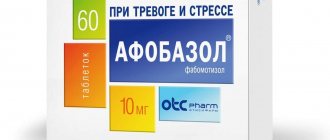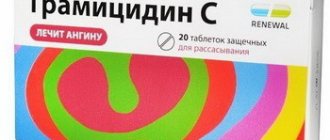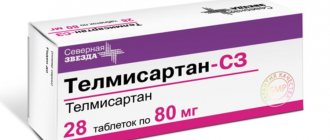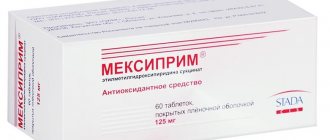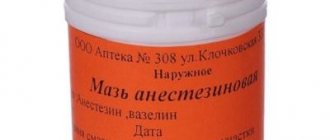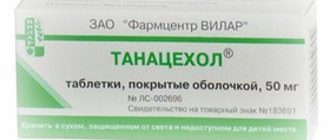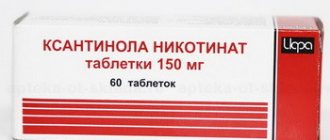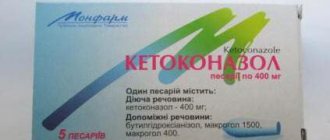There are restrictions during pregnancy
Prohibited during breastfeeding
Has restrictions for children
Can be taken by older people
Has limitations for liver problems
Has limitations for kidney problems
Today, more and more people suffer from various psychotic disorders, which are often accompanied by psychomotor agitation, aggression, and motor restlessness. To treat such conditions, special drugs are prescribed - antipsychotics. One of the popular representatives of this group is Tiapridal, which, according to the instructions for its use, has a complex antipsychotic, analgesic, sedative and mild hypnotic effect on the human body.
Composition of the product and release form
The pharmaceutical industry produces Tiapride in two forms:
- tablets for oral administration;
- injection.
Tablets of the most common type: white, flat, odorless. One side has a stripe that seems to divide the tablet into 4 parts, the other side has the letters “T100”.
One tablet contains 100 mg of the active substance (tiapride) and additional components.
The drug is packaged in plastic transparent blisters, packed in cardboard boxes. One blister contains 10 tablets.
There is a second type of packaging: the same cardboard boxes, but inside there are not blisters, but opaque glass jars, each containing 30 tablets.
One ampoule contains 100 mg of tiapride and additional components. Glass ampoules are placed in plastic cell packaging. One such package includes 6 ampoules. Each ampoule contains 2 ml of pharmaceutical preparation.
Analogues of the drug
In Russian pharmacies there is a complete structural analogue of Tiapride, which is produced in France by the pharmaceutical industry under the trade name Tiapridal. This drug has two forms of release: tablets No. 20 and ampoules No. 12, containing 2 ml of injection solution.
It has anxiolytic, hypnotic, sedative and analgesic effects. It does not have a negative effect on the extrapyramidal system, which makes it possible to use it for the treatment of parkinsonism. The price is significantly higher than the domestic drug, but at the moment Tiapridal is temporarily unavailable for sale due to re-registration.
As substitutes for Tiapride, you can use other drugs from the benzamide group, which have a similar therapeutic effect, but differ in the active ingredient:
- Betamax (Grindeks, Latvia): available only in the form of tablets containing 50, 100, 200 mg of sulpiride. It has a lasting effect in the treatment of delirium, schizophrenia, depression, and headaches of neurogenic origin.
- Limipranil (Rivofarm SA, Switzerland): thick film-coated, enteric tablets containing 50, 100, 200, 400 mg of amisulpride. Unlike Tiapride, they act not only on dopaminergic receptors of type D2, but also type D3, which allows this drug to be used to relieve acute attacks of schizophrenia with hallucinatory, delusional syndrome, as well as negative symptoms (withdrawal from society, suppression of emotionality).
- Solian (Sanofi-Aventis, France): tablets of 100, 200, 400 mg of amisulpride, a dopaminergic receptor blocker, are available. It has a neuroleptic, analgesic and moderate sedative effect. A special feature is the presence of a special solution for oral administration, which is available in a 60 ml glass bottle complete with a special dispenser syringe. This allows precise dosage calculations for use in children.
Pharmacological profile
Tiapride is positioned as a drug that does not cause, or almost does not cause, adverse reactions, equally suitable for adults and children.
The mechanism of action of the drug is based on blocking receptors in various sectors of the brain:
- the decrease in body temperature occurs due to the thermoregulation center located in the hypothalamus;
- relief of severe attacks of vomiting is ensured by blocking the receptors of the vomiting center;
- the antipsychotic effect is achieved by blocking the recipes responsible for the production of dopamine, the hormone that “promises joy”.
Additionally, the medication is able to act on dopamine receptors, and also controls the “release” of dopamine; it is equally effective both with its deficiency and with its excess.
Neurotransmitters affected by antipsychotics
Both doctors and patients who have used Tiapride note its pronounced analgesic and hypnotic effect. The analgesic effect is so powerful that the medicine is successfully used to relieve pain attacks in cancer patients.
The medicine is also used for the complex treatment of alcoholism, depression, and opium addiction. At the same time, acting as a catalyst, it enhances the effect of other antipsychotic drugs.
The degree of absorption of the active substance is 75%, the therapeutic effect is further enhanced if the drug is taken before meals. When taking 200 mg in tablet form, its highest concentration in the blood occurs after an hour, when administering a solution - after 30 minutes.
In older patients, the degree of absorption decreases. The drug is excreted by the kidneys and 70% is found unchanged in the urine.
Tiapride underwent clinical studies, as a result of which its ability to overcome the protective barrier of the placenta was recorded. During pregnancy, therefore, this medicine is not prescribed.
General information about Tiapridal
Tiapridal is a popular antipsychotic drug. It is produced by the famous pharmaceutical corporation from France “Sanofi”.
Drug group, INN, application
The drug belongs to a special group of drugs – antipsychotics. Such drugs affect the central nervous system, effectively relieving the symptoms of mental disorders.
Description of the drug
The international nonproprietary name is the name of the active substance contained in the medicine and determines its mechanism of action. Often it does not coincide with the trade name. So, the INN of Tiapridal is Tiaprid. This remedy is widely used in psychiatric medical practice. It can also be prescribed by neurologists, therapists and pediatricians.
Pharmacological forms and price of Tiapridal
On pharmacy shelves, the drug is presented in 2 pharmaceutical forms - tablets and solution. They have some differences in the method of use, indications for use, and composition. Their characteristics:
- Tablets for oral use are white-cream in color and round, flat in shape. On one side of the tablet there is a dividing cross-shaped mark, on the reverse there is an engraving Tiapridal 100. They are packaged in aluminum foil blisters of 10 pieces. 20 or 30 tablets are placed in a cardboard packaging box.
- The injection solution has the form of a clear, colorless liquid, which is contained in 2 ml glass ampoules. A total of 12 such ampoules are placed in the package.
The retail price of a medicine depends on the form of its release and the place of purchase. Examples of the cost of the drug in different pharmacies in Russian cities:
| Pharmaceutical form of Tiapridal | Pharmacy, city | Cost in rubles |
| Tablets 100 mg (20 pieces) | BALTIKA-MED, St. Petersburg | around 1360 |
| 100 mg No. 20 | Pharmakeya, St. Petersburg | 1550 |
| 100 mg (20 pieces) | Farmalizing LLC, St. Petersburg | 1198 |
| Solution 50 mg\ml, 12 ampoules of 2 ml | Farmalizing LLC, St. Petersburg | 1170 |
| 100 mg (30 tablets) | GORZDRAV, Moscow and region | 1634 |
| 100 mg (20 pieces) | GORZDRAV, Moscow and region | 1390 |
| 100 mg No. 20 | Online pharmacy 36.6, Moscow | 1303 |
| Solution 50 mg\ml, 12 ampoules of 2 ml | Vitamin, St. Petersburg | 1135 |
Compound
The drug contains the active substance tiapride. Its concentration, as well as the list of auxiliary components, is determined by the release form. One tablet contains the base component - 100 mg of Tiapridum, as well as additional components - cellulose, povidone, magnesium stearate, silicon dioxide and mannitol.
1 ml of solution contains 50 mg of tiapride, sodium chloride and special water for injection.
Pharmacodynamics and pharmacokinetics
The pharmacodynamics of the drug is based on the action of its active substance. Tiapride selectively blocks dopamine receptors in brain structures. The following effects are observed:
- antipsychotic;
- soothing;
- analgesic;
- mild sleeping pill;
- antiemetic;
- hypothermic (impact on dopamine receptors in the hypothalamus).
Mechanism of action of antipsychotic drugs
Tiapride is able to block only D2 dopa receptors without affecting D1 receptors. This substance has the following pharmacokinetic properties:
- Well absorbed from the digestive tract. Its maximum levels in the blood differ depending on the method of administration - 200 mg of tiapride from tablets reaches a maximum after an hour, the same amount of the active component when administered intramuscularly - after half an hour.
- The overall bioavailability level is about 70%. When taking the medicine before meals, it increases by 20%.
- It is quickly distributed throughout the body, but does not accumulate in tissues and fluids.
In elderly patients, slower absorption is observed. The drug is able to penetrate the placental and blood-brain barrier, and is also excreted in breast milk. The metabolic process in the liver is weak - about 70% of the substance is excreted unchanged.
It is excreted primarily by the kidneys. The half-life is influenced by gender - in women this period lasts a little less than 3 hours, in men it lasts more than 3 and a half hours. In cases of renal impairment, half-life depends on creatinine clearance. The lower it is, the slower tiapride is excreted. Therefore, patients with clearance below 20 ml per minute require a dose reduction by half.
Tiapridal's analogs
The most popular analogues of Tiapridal:
- Sulpiride. A domestically produced neuroleptic containing a consonant active component (sulpiride). It is used for psychosis, depression, migraines, stress ulcers in the digestive organs, behavioral disorders in children. The cost of the drug is low - from 60 to 150 rubles per pack of 30 tablets (50 or 200 mg of sulpiride).
Eglonil. A drug from France (Sanofi) based on sulpiride. Release form: tablets of 200 mg of active substance. It has a stimulating, antidepressant and antiemetic effect.- Tiapride. This is a structural analogue of Tiapridal with a similar composition. It has identical indications and contraindications. Produced by the domestic pharmaceutical industry in the form of tablets. An effective and inexpensive drug.
See also:
Neupilept - instructions for use, analogues and reviews
Indications for use
The medication in one dosage form or another is prescribed to patients of different age groups.
Application in tablet form
Tiapride tablets for adults are prescribed for:
- correction of behavioral reactions in age-related dementia;
- relief of constant severe pain attacks in cancer patients;
- eliminating pain in depression;
- relief of joint pain and headaches;
- reducing agitation and attacks of aggression in alcoholic illness.
Adult patients and children (after 6 years) with:
- chorea: chronic, secondary, mixed, etc.;
- manifestations of aggression and agitation in children;
- Gilles de la Tourette syndrome.
Purpose of the solution
The solution for intramuscular and intravenous administration is used for the following diagnoses:
- Parkinson's disease;
- chorea and tics;
- tremors of the limbs - tremor;
- alcohol psychosis and withdrawal syndrome;
- for the purpose of behavior correction in elderly patients.
Indications and contraindications
In psychiatry, Tiapride is prescribed to eliminate productive symptoms in patients with schizophrenia, as well as for the treatment of depressive disorders and psychoses of various origins, and in older people to normalize cognitive functions. In narcology, it is used in the complex treatment of alcoholism and drug addiction to prevent the development of withdrawal syndrome.
Withdrawal syndrome
In neurology, the use of this drug for the treatment of the following pathologies is widespread:
- hyperkinesis;
- dyskinesia;
- Tourette's syndrome;
- chorea;
- nervous tics;
- parkinsonism syndrome;
- severe visceral pain;
- neurogenic headache.
Tourette's syndrome
It is prohibited to use Tiapride to treat pregnant women, as well as during lactation. The age limit according to the manufacturer's recommendations is 18 years. However, if there is an urgent need, it can be used in pediatric practice to treat children over 6 years of age under the constant supervision of a physician.
Among the contraindications to the use of this medicine are the following diseases:
- Neoplasms dependent on prolactin levels (tumors of the pituitary gland and mammary gland).
- Individual hypersensitivity.
- Pheochromocytoma.
- Severe anemia, blood and bone marrow diseases.
Contraindications for use
Tiapride has absolute and conditional contraindications. Unconditional contraindications to the use of the drug in any form are:
- patient intolerance to any component of the drug;
- established or suspected pheochromocytoma;
- pregnancy in the first trimester (penetration of the active ingredient through the placental barrier has been established);
- sudden surges in pressure; hypertensive crisis;
- breast-feeding;
- the presence of certain types of tumors in the patient, as well as suspicion of them, it is worth noting that this mainly concerns prolactin-dependent neoplasms, due to the fact that tiapride affects the production of prolactin, and this in turn affects the entire hormonal sphere;
- age group of children under 6 years old.
There are a number of conditions for which the medication can be used, but with extreme caution:
- diseases of the heart and cardiovascular system - due to the threat of the risk of developing and intensifying ischemic disorders against the background of low blood pressure;
- in old age, the drug is prescribed with caution due to the possible occurrence of sedation - a relaxed and peaceful state, almost half asleep;
- senile dementia;
- identified patient predisposition to stroke;
- renal failure (the use of the drug is possible with careful adherence to dosage);
- epilepsy (the property of neuroleptics to reduce the epileptogenic threshold is taken into account);
- established thromboembolism or the possibility of its occurrence;
- pregnancy;
- children's age, due to insufficient knowledge of the action of the active component of the drug;
- adolescents - pharmaceuticals may have an undesirable effect on the endocrine system;
- simultaneous use by the patient of ethanol-containing medications.
The patient's presence of arrhythmia or the possibility of its occurrence, electrolyte imbalance and slow heartbeat may also limit the use of Tiapride. In these cases, the drug can provoke severe ventricular heart rhythm disturbances and the occurrence of ventricular tachycardia.
Contraindications
- Pheochromocytoma (suspected or diagnosed);
- Hypertensive crisis;
- Prolactin-dependent tumors (suspected or diagnosed, for example, breast cancer, pituitary prolactinoma);
- Severe liver and/or renal failure;
- Simultaneous use with sultopride;
- Concomitant use with drugs that can cause arrhythmias: antiarrhythmic drugs of class I A (disopyramide, hydroquinidine, quinidine) and class III (dofetilide, amiodarone, sotalol, ibutilide), some antipsychotics (trifluoperazine, levomepromazine, haloperidol, thioridazine, amisulpride, chlorpromazine, cyamemazine, pimozide, sulpiride, droperidol), as well as with the following drugs: cisapride, levodopa, mizolastine, bepridil, erythromycin, difemanil, sparfloxacin, vincamine (intravenous), moxifloxacin;
- Concomitant use with dopamine receptor agonists (bromocriptine, amantadine, ropinirole, apomorphine, lisuride, cabergoline, entacapone, piribedil, pergolide, quinagolide, pramipexole), except for use in patients with Parkinson's disease;
- First trimester of pregnancy and lactation (breastfeeding);
- Age up to 6 years;
- Hypersensitivity to the components of the drug.
Tiapridal should be used with caution concomitantly with drugs that can cause hypokalemia, severe bradycardia (heart rate less than 55 beats per minute), prolongation of the QT interval or slowing of cardiac conduction, with drugs containing ethanol, in elderly patients, as well as in the following diseases: states:
- Epilepsy (due to the possibility of lowering the seizure threshold);
- Chronic renal failure (if used, reduce the dose and increase monitoring);
- Parkinson's disease;
- Cardiovascular diseases in the stage of decompensation;
- Hypokalemia;
- Bradycardia (heart rate less than 55 beats per minute);
- Congenital prolongation of the QT interval.
Instructions for use
Regardless of the form (tablets or injection solution), the initial doses are always minimal. During subsequent examinations of the patient, the doctor either leaves the dosage the same or increases it.
Depending on the condition and age of the patient, the severity of his condition, concomitant diseases, 25 to 1800 mg of Tiapride per day is prescribed.
The daily dose is usually taken 2-3 times (in severe cases, the drug is administered 4 to 6 times a day).
Course of treatment and dosage for adult patients
Taking the medication in tablet form:
- Constant pain of various nature : the daily norm is 200-400 mg.
- Excitement, attacks of aggression and anger in alcoholism and related disorders . The maximum amount is 200-300 mg per day. Application period – 30-60 days.
- Chorea, Gilles de la Tourette's syndrome . Adult dose 300-800 mg. The initial amount of the drug taken is minimal - 25 mg per day. The most effective dose is established gradually by increasing it step by step.
For elderly patients, the daily amount of medication 200-300 mg is achieved gradually. The first doses are 50 mg twice a day. As prescribed by the doctor, the dose can be increased by 50-100 mg every 2-3 days. In this case, the average dose will be 200 mg, and the maximum allowable dose will be 300 mg.
The solution for intramuscular and intravenous administration is prescribed only to adult patients:
- for constant severe pain, including cancer: 200-400 mg per day;
- in case of qualitative disturbances of consciousness, delirium, predelirious state, the patient is administered in parts from 200 to 1200 mg of medication per day, the interval is 4-6 hours, and in severe cases the dose can be increased to 1800 mg per day.
Children's dosages
Tiapride tablets are prescribed to children over 6 years of age:
- Gilles de la Tourette syndrome, chorea of various types and origins: 3-6 mg/kg per day (children over 6 years old);
- aggression and agitation: 100-150 mg per day (children over 6 years old).
The injection solution for the same indications is administered in an amount of 100-150 mg per day. As prescribed by the doctor, the dose can be increased, but it cannot exceed 300 mg per day (children over 7 years old).
Compared to other medications of similar action, the side effects of Tiapride are much less pronounced; this property makes it possible to use it in child neurology and psychiatry.
For severe chronic and motor tics, the medication is prescribed in an amount sufficient to relieve attacks. Here it is especially important to comply with the conditions for gradual withdrawal of the drug. Dose reduction and then complete withdrawal are carried out within 6-12 months.
Tiapridal®
Neuroleptic malignant syndrome
Neuroleptic malignant syndrome is characterized by pallor, hyperthermia, muscle rigidity, dysfunction of the autonomic nervous system, and impaired consciousness. Signs of autonomic nervous system dysfunction, such as increased sweating and lability of blood pressure and pulse, may precede the onset of hyperthermia and therefore represent early warning symptoms. If there is an unexplained increase in body temperature, treatment with tiapride should be discontinued. The cause of the development of neuroleptic malignant syndrome remains unclear. It is assumed that blockade of dopamine receptors in the striatum and hypothalamus plays a role in its mechanism; congenital predisposition (idiosyncrasy) cannot be ruled out. The development of the syndrome can be facilitated by intercurrent infection, disturbances in water and electrolyte balance (in particular, dehydration, hyponatremia), simultaneous administration of lithium, and organic brain damage.
Extending the OT interval
Tiapride may cause QT prolongation. This effect is known to increase the risk of developing serious ventricular arrhythmias, such as torsade de pointes (see section 4.4).
Before prescribing antipsychotic therapy, if the patient's condition allows, it is necessary to exclude the presence of factors predisposing to the development of these severe rhythm disturbances (bradycardia less than 55 beats per minute, hypokalemia, hypomagnesemia, slow intraventricular conduction and congenital long QT interval or prolongation of the QT interval when using other drugs , prolonging the QT interval) (see sections “Contraindications”, “With caution”, “Side effects”).
Patients with the above risk factors,
predisposing to prolongation of the QT interval, if it is necessary to prescribe tiapride, special care must be taken.
Hypokalemia and hypomagnesemia should be corrected before starting the drug, in addition, medical supervision, monitoring of blood electrolytes and ECG should be provided.
Extrapyramidal
y
syndrome
For extrapyramidal syndrome caused by antipsychotics, anticholinergic drugs (rather than dopamine receptor agonists) should be prescribed (see section “Interaction with other drugs”).
Stroke
In randomized clinical trials comparing some atypical antipsychotics with placebo in elderly patients with dementia, a threefold increase in the risk of cerebrovascular events was observed. The mechanism of this risk is unknown. An increase in this risk cannot be ruled out with other antipsychotics or in other patient populations, so tiapride should be used with caution in patients with risk factors for stroke.
Elderly patients with dementia
In elderly patients with dementia-related psychosis, an increased risk of death was observed when treated with antipsychotic drugs. An analysis of 17 placebo-controlled studies (mean duration greater than 10 weeks) found that most patients treated with atypical antipsychotics had a 1.6 to 1.7 times greater risk of death than patients treated with placebo. In a 10-week placebo-controlled study, the incidence of death in these patients was 4.5% with atypical antipsychotics and 2.6% with placebo.
Although the causes of death in clinical studies with atypical antipsychotics varied, most causes of death were either cardiovascular (eg, heart failure, sudden death) or infectious (eg, pneumonia) in nature. Observational studies have confirmed that, like treatment with atypical antipsychotics, treatment with conventional antipsychotics may also increase mortality. The extent to which the increase in mortality may be due to the antipsychotic drug rather than certain patient characteristics is unclear.
Venous thromboembolic complications
When using antipsychotic drugs, cases of venous thromboembolic complications (VTE), sometimes fatal, have been observed (see section "Side effects"). Therefore, tiapride should be used with caution in patients with risk factors for developing HTO. Since patients taking antipsychotics often have acquired risk factors for developing HTO, any potential risk factors for developing HTO should be identified before and during treatment with Tiapridal, and measures aimed at preventing thromboembolic complications should be implemented while taking it.
Mammary cancer
Tiapride may increase the concentration of prolactin in the blood plasma. Therefore, when using tiapride in patients with a history (including family history) of breast cancer, caution should be exercised (see section "With caution"). Such patients should be closely monitored.
Patients with epilepsy
Due to the fact that tiapride may lower the threshold for seizure activity, when tiapride is prescribed to patients with epilepsy, the latter should be under strict medical supervision.
Patients with Parkinson's disease taking
dopamine receptor agonists
Except in exceptional cases, Tiapridal should not be used in patients with Parkinson's disease.
If there is an urgent need for antipsychotic treatment in patients with Parkinson's disease taking dopamine receptor agonists, a gradual reduction in dosage of the latter should be carried out until complete discontinuation (abrupt withdrawal of dopamine receptor agonists may increase the patient's risk of developing neuroleptic malignant syndrome) (see sections "With
caution", "Interaction with other drugs").
Children
The use of tiapride in children has not been studied enough. Therefore, caution should be used when prescribing tiapride to children. Due to the lack of clinical data, caution is recommended when prescribing this drug to children. Moreover, it is recommended to have children's learning abilities tested annually, as the drug may affect cognitive function. It is necessary to regularly adjust the dose depending on the clinical condition of the child. Hematological disorders
Leukopenia, neutropenia and agranulocytosis have been observed with the use of antipsychotic drugs, including Tiapridal®. Unexplained infections or fever may be signs of hematological disorders (see section "Side effects") and require immediate hematological evaluation.
Ethanol
During treatment with Tiapridal, you should not take alcoholic beverages or medications containing ethanol (see section “Interaction with drugs and other drugs”).
Side effects and cases of overdose
Side effects of the drug can affect the nervous system, sensory organs, urinary and reproductive systems.
From the nervous system and sensory organs:
- fast fatiguability;
- drowsiness or agitation;
- involuntary movements of the eyes and eyelids;
- spasms;
- somatic and vegetative disorders.
From the urinary and reproductive systems the following may be observed:
- gynecomastia;
- frigidity;
- impotence.
Cases of overdose
In case of an overdose of tablets, the following are observed:
- state of “half-asleep”, drowsiness and drowsiness;
- possible onset of coma;
- a sharp decrease in blood pressure.
Mostly, an overdose of the solution is characterized by:
- exceeding the norm of sedation several times;
- decreased heart rate and sharp decrease in blood pressure, fainting.
In such cases, it is necessary to stop taking the medication, washing procedures, therapeutic measures aimed at detoxifying the body, and plasmapheresis are carried out.
Any excess of the dosage prescribed by the attending physician leads to dire consequences. For example, if a doctor prescribes 2 tablets and the patient takes 4, the body's reaction may be unpredictable.
Side effects, overdose symptoms
Tiapridal often provokes the development of various negative reactions. The patient may experience the following side effects:
- asthenic syndrome (weakness, fatigue);
- sleep problems (drowsiness or insomnia);
- headaches and dizziness;
- increased psychomotor agitation;
- apathy, lethargy, fatigue;
- dyskinesia, dystonic manifestations (disappear after discontinuation of the drug);
- hyperprolactinemia;
Hyperprolactinemia in women
- the appearance of excess weight;
- cardiovascular abnormalities (arrhythmia, postural hypotension);
- development of neuroleptic malignant syndrome.
Patients with parkinsonism often experience tremor, bradykinesia, and increased blood pressure. Long-term use of the drug may cause tardive dyskinesia, which is characterized by involuntary movements of the tongue, head, arms and legs.
Overdose is accompanied by the following symptoms:
- sedation;
- extrapyramidal disorders;
- drowsiness, lethargy;
- depression of consciousness;
- coma.
Treatment of overdose begins with stopping the drug. If a high dose of tablets is taken, it is advisable to do gastric lavage. Next, symptomatic therapy is prescribed. It is important to monitor the activity of vital organs (heart, lungs). There is no special antidote. Hemodialysis is not effective.
See also:
Truxal - instructions for use, reviews, indications and analogues
special instructions
During the course of taking Tiapride, alcohol is strictly prohibited. In addition, even ethanol-containing drugs prescribed by a doctor are taken with great caution. To avoid life-threatening situations for the driver and passengers, you should refrain from driving, active sports and activities that require increased attention and immediate reaction.
Tiapride is never used simultaneously with Levodopa, drugs that slow the heart rate and cause bradycardia. The medicine should not be taken with pharmaceuticals that affect the electrolyte balance of the body or with laxatives. If a situation arises when these drugs are necessary for health reasons, careful medical supervision of the patient is carried out.
Subject to all safety precautions, Tiapride is used in conjunction with antiparkinsonian drugs and morphine.
Ethanol enhances the sedative effect of all antipsychotics. During the course of treatment, alcoholic beverages are prohibited and medications containing ethanol are used with great caution.
Prescription for liver and kidney failure
Due to very little metabolism, no dosage changes are required for liver dysfunction.
In renal failure, a different picture is observed. The amount of the drug taken directly depends on creatinine clearance (C/C):
- with C/C 30-60 ml/min, the standard dose is reduced by 25%;
- with C/C 10-30 ml/min – the amount of the drug taken is reduced by 2 times;
- with C/C 10 ml/min, the dose is reduced by 4 times compared to the standard dose prescribed for normal functioning of the organ.
Prescription during pregnancy and lactation
The protective placental barrier is not an obstacle to the active component of the antipsychotic. This is especially true for pregnancy in the first trimester. If the use of the drug is necessary for health reasons, if the risks are justified, Tiapride is prescribed after a thorough examination of the patient, administration is carried out under constant medical supervision, and the quantity and duration of administration is reduced to the minimum possible.
No doctor can guarantee one hundred percent health of the baby when the expectant mother takes antipsychotic medications. If the patient took Tiapride for a long time during pregnancy, the newborn comes under the supervision of pediatric neurologists from the first days of life.
It is not known whether the active ingredient can pass into the milk of a nursing woman. But there is evidence from experiments on animals that have documented this ability. The consequences for the child are not predicted, and there are two possible solutions - either completely stop taking the antipsychotic, or reduce the dosage as much as possible.
Drug interactions
Tiapridal is contraindicated for use simultaneously with levodopa, cabergoline, quinagolide, since mutual antagonism is observed.
Ethanol enhances the sedative effect of the drug, so it is also prohibited during treatment.
Tiapride is not recommended for use in combination with the following drugs:
- drugs that can cause torsades de pointes or prolong the QT interval: beta-blockers, slow calcium channel blockers (diltiazem, verapamil), cardiac glycosides, clonidine, guanfacine, potassium-sparing diuretics, amphotericin B (intravenous), tetracosactide, glucocorticosteroids, laxatives, stimulating intestinal motility;
- selective serotonin reuptake inhibitors (escitalopram, citalopram);
- class IA antiarrhythmic drugs (quinidine, disopyramide);
- class III antiarrhythmic drugs (sotalol, ibutilide, dofetilide, amiodarone);
- other drugs: intravenously administered spiramycin, imipramine derivatives, antidepressants, bepridil, cyamemazine, haloperidol, sultopride, sulpiride, droperidol, amisulpride, thioridazine, pipothiazine, chlorpromazine, veralipride, methadone, sertindole, intravenous erythromycin, difemanil methyl sulfate, levomepromazine, halofantrine, moxifloxacin , sparfloxacin, lumefantrine, intravenous vincamine, cisapride, pimozide, pentamidine, mizolastine, lithium preparations;
- dopaminergic antiparkinsonian drugs (lisuride, entacapone, pramipesol, bromocripine, amantadine, ropinirole, piribedil, pergolide, apomorphine, selegiline).
Combinations requiring caution:
- cholinesterase inhibitors (neostigmine bromide, pyridostigmine bromide, rivastigmine, donepezil, galantamine): bradycardia may develop, the risk of developing ventricular arrhythmias increases;
- antihypertensive drugs: the antihypertensive effect increases, the likelihood of developing orthostatic hypotension increases;
- nitrates: the risk of lowering blood pressure and developing orthostatic hypotension increases;
- drugs that depress the function of the central nervous system, due to the likelihood of cumulative depression of the central nervous system and a decrease in response: morphine derivatives (analgesics, antitussives); H2-histamine receptor blockers with sedative effects; benzodiazepines and other anxiolytics; barbiturates; antidepressants with sedative effects (mirtazapine, mianserin, amitriptyline, trimipramine, doxepin), hypnotics, pizotifen, thalidomide, baclofen.
From application practice
On the Internet there are opinions of doctors and patients who have used Tiapride, there are tips for use, positive and negative reviews.
The drug significantly reduces or completely eliminates tics, relieves anxiety and hyperexcitability. Equally well tolerated by children and elderly patients. Side effects are rare and, compared to other antipsychotics, are much less pronounced.
Psychiatrist, Saratov
Tiapride is an excellent drug, but its price has been greatly increased. Many people couldn't afford it. Cheaper analogues either have a lot of side effects or are many times inferior in terms of therapeutic effect.
Psychiatrist. Tomsk city
The child was prescribed medication for tics - it helped.
Marina
The drug is serious. Taking without a doctor's prescription is dangerous. I checked it for myself!
"Pianist"
Powerful medicine. Anxiety and irritability are gone, sleep is wonderful. What did you get in return? Stiffness in movement, problems with speech - minor, but true. In general, the drug is quite mild compared to the same Aminazine. Yes, and one more thing - the analgesic effect is excellent.
Freegabalin
Helps well with alcohol addiction.
Filin. Paramedic 03
Judging by the reviews and opinion of doctors, the drug has more advantages than disadvantages. Both doctors and those who have used Tiapride advise starting with the smallest doses and stopping it gradually.
Before starting a course of treatment, for example, for a state of constant anxiety, first find out exactly the nature of its occurrence. Do not neglect consultations with psychologists and psychotherapists.
Do not expect an immediate improvement in memory when taking Tiapride - the effect of the drug is cumulative; in order for it to fully manifest itself, several days must pass.
Another problem that worries many is an increase in prolactin levels. Patients note a significant “surge” of the hormone, disruptions in the menstrual cycle, which are fraught with serious female diseases.
Similar drugs:
- Aminazine Dragee
- Sulpirid Tablets
- Azaleptin Semi-finished powder
- Lithium carbonate (Lithii carbonas) Oral tablets
- Droperidol Solution for intravenous and intramuscular administration
- Egolanza Oral tablets
- Rispaksol Oral tablets
- Sulpirid Oral solution
- Thiodazine Oral tablets
- Clopixol Depot Solution for intramuscular administration
** The Drug Directory is intended for informational purposes only. For more complete information, please refer to the manufacturer's instructions. Do not self-medicate; Before starting to use the drug Tiapridal, you should consult a doctor. EUROLAB is not responsible for the consequences caused by the use of information posted on the portal. Any information on the site does not replace medical advice and cannot serve as a guarantee of the positive effect of the drug.
Are you interested in the drug Tiapridal? Do you want to know more detailed information or do you need a doctor's examination? Or do you need an inspection? You can make an appointment with a doctor - the Euro lab is always at your service! The best doctors will examine you, advise you, provide the necessary assistance and make a diagnosis. You can also call a doctor at home . Euro lab clinic is open for you around the clock.
** Attention! The information presented in this medication guide is intended for medical professionals and should not be used as a basis for self-medication. The description of the drug Tiapridal is provided for informational purposes and is not intended for prescribing treatment without the participation of a doctor. Patients need to consult a specialist!
If you are interested in any other drugs and medications, their descriptions and instructions for use, information about the composition and form of release, indications for use and side effects, methods of use, prices and reviews of drugs, or you have any other questions and suggestions - write to us, we will definitely try to help you.
What to replace the medicine with?
Similar in action are Haloperidol, Aminazine, Azapine, Quetiapine. But these drugs are stronger and have more side effects.
Speaking about analogues, we should mention Eglonil, Betamax and the Russian-made drug Tiapridal, in which the active substance is the same as in Tiapride.
The instructions mention that analogues are selected when the original cannot be used in conjunction with other prescribed drugs, when side effects are too pronounced, or when the therapeutic effect does not correspond to the expected result.
Symptoms and treatment of overdose
Symptomatic signs of an overdose of Tiapridal appear as:
- depression of the central nervous system;
- increased blood pressure;
- dysfunction of the extrapyramidal nervous system;
- increased drowsiness and rapid increase in feeling of fatigue;
- comatose state.
To relieve symptoms of overdose you must:
- abruptly discontinue the use of Tiapridal;
- take a medication that provokes the development of a gag reflex;
- carry out therapy aimed at eliminating the symptoms of intoxication with parallel monitoring of the functioning of vital organs and systems.
Until now, no specific antidote has been developed.
Patients with clinical signs of overdose should be closely monitored by medical professionals.

